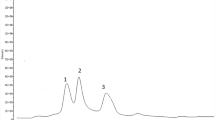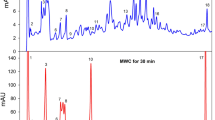Abstract
Brassica oleracea L. var. botrytis leaves are commonly used leafy vegetables in Pakistan; however, there is a lack of literature regarding the detailed composition of carotenoids, chlorophylls contents. The study was conducted to determine variations in carotenoids, chlorophylls, total phenolic, and flavonoids contents, and antioxidant activity of B. oleracea L. from the selected regions in Pakistan. Carotenoids and chlorophylls were determined using reversed-phase HPLC-DAD; other parameters were determined using spectroscopic methods. Twelve carotenoids and 9 chlorophylls were present in all samples. The β-carotene, lutein, fucoxanthin, δ-carotene, neoxanthin, γ-carotene, and phytoene were the major carotenoids. Chlorophyll b, chlorophyllide a, 13′-hydroxy-lactone chlorophyll b, hydroxyl-pheophytin a, and 15′-hydroxy-lactone chlorophyll a were the major chlorophylls in B. oleracea leaves. Variations occurred among carotenoids and pigment contents in samples. Total phenolic contents, flavonoids contents, and radical scavenging activity exhibited variations among samples. These results indicated that B. oleracea leaves from the selected locations in Pakistan were a good source of important phytochemicals especially carotenoids and chlorophylls for potential food and nutraceutical industries.




Similar content being viewed by others
References
Ahmed FA, Ali RFM (2013) Bioactive compounds and antioxidant activity of fresh and processed white cauliflower. Biomed Res Int 2013:Article ID 367819. https://doi.org/10.1155/2013/367819
Ares AM, Nozal MJ, Bernal J (2013) Extraction, chemical characterization and biological activity determination of broccoli health promoting compounds. J Chromatogr A 1313:78–95. https://doi.org/10.1016/j.chroma.2013.07.051
Beacham AM, Hand P, Pink DAC, Monaghan JM (2017) Analysis of Brassica oleracea early stage abiotic stress responses reveals tolerance in multiple crop types and for multiple sources of stress. J Sci Food Agric 97:5271–5277. https://doi.org/10.1002/jsfa.8411
Beecher CWW (1994) Cancer preventive properties of varieties of Brassica oleracea - a review. Am J Clin Nutr 59:1166s–1170s
Chang C-C, Yang M-H, Wen H-M, Chern J-C (2002) Estimation of total flavonoid content in propolis by two complementary colorimetric methods. J Food Drug Anal 10:178–182
Chen K, Ríos JJ, Pérez-Gálvez A, Roca M (2015) Development of an accurate and high-throughput methodology for structural comprehension of chlorophylls derivatives. (I) Phytylated derivatives. J Chromatogr A 1406:99–108. https://doi.org/10.1016/j.chroma.2015.05.072
Cheung WY, Champagne G, Hubert N, Landry BS (1997) Comparison of the genetic maps of Brassica napus and Brassica oleracea. Theor Appl Genet 94:569–582. https://doi.org/10.1007/s001220050453
Cirkovic-Velickovic TD, Stanic-Vucinic DJ (2018) The role of dietary phenolic compounds in protein digestion and processing technologies to improve their antinutritive properties. Compr Rev Food Sci Food Saf 17:82–103. https://doi.org/10.1111/1541-4337.12320
de Rosso VV, Mercadante AZ (2007) Identification and quantification of carotenoids, by HPLC-PDA-MS/MS, from amazonian fruits. J Agric Food Chem 55:5062–5072. https://doi.org/10.1021/jf0705421
dos Reis LCR, de Oliveira VR, Hagen MEK, Jablonski A, Flôres SH, de Oliveira RA (2015a) Carotenoids, flavonoids, chlorophylls, phenolic compounds and antioxidant activity in fresh and cooked broccoli (Brassica oleracea var. avenger) and cauliflower (Brassica oleracea var. Alphina F1). LWT Food Sci Technol 63:177–183. https://doi.org/10.1016/j.lwt.2015.03.089
dos Reis LCR, de Oliveira VR, Hagen MEK, Jablonski A, Flores SH, Rios AD (2015b) Effect of cooking on the concentration of bioactive compounds in broccoli (Brassica oleracea var. avenger) and cauliflower (Brassica oleracea var. Alphina F1) grown in an organic system. Food Chem 172:770–777. https://doi.org/10.1016/j.foodchem.2014.09.124
Frank HA, Young A, Britton G, Cogdell RJ (2006) The photochemistry of carotenoids, vol 8. Springer Science & Business Media
Guzman I, Yousef GG, Brown AF (2012) Simultaneous extraction and quantitation of carotenoids, chlorophylls, and tocopherols in brassica vegetables journal of agriculture and. Food Chem 60:7238–7244. https://doi.org/10.1021/jf302475d
Humphries JM, Khachik F (2003) Distribution of lutein, zeaxanthin, and related geometrical isomers in fruit, vegetables, wheat, and pasta products. J Agric Food Chem 51:1322–1327. https://doi.org/10.1021/jf026073e
Hwang S-J, Chun J-H, Kim S-J (2017) Effect of cold stress on carotenoids in kale leaves (Brassica oleracea). Korean J Environ Agric 36:106–112
Jian Y, Zhang C, Wang Y, Li Z, Chen J, Zhou W, Huang W, Jiang M, Zheng H, Li M, Miao H (2021) Characterization of the role of the neoxanthin synthase gene BoaNXS in carotenoid biosynthesis in Chinese kale Genes 12(8):1122. https://doi.org/10.3390/genes12081122
Khachik F, Beecher GR, Whittaker NF (1986) Separation, identification, and quantification of the major carotenoid and chlorophyll constituents in extracts of several green vegetables by liquid chromatography. J Agric Food Chem 34:603–616. https://doi.org/10.1021/jf00070a006
Kiefer C, Hessel S, Lampert JM, Vogt K, Lederer MO, Breithaupt DE, von Lintig J (2001) Identification and characterization of a mammalian enzyme catalyzing the asymmetric oxidative cleavage of provitamin A. J Biol Chem 276:14110–14116. https://doi.org/10.1074/jbc.M011510200
Kopsell DE, Kopsell DA, Randle WA, Coolong TW, Sams CE, Curran-Celentano J (2003) Kale carotenoids remain stable while flavor compounds respond to changes in sulfur fertility. J Agric Food Chem 51:5319–5325. https://doi.org/10.1021/jf034098n
Kopsell DA, Kopsell DE, Lefsrud MG, Curran-Celentano J, Dukach LE (2004) Variation in lutein, beta-carotene, and chlorophyll concentrations among Brassica oleracea cultigens and seasons. Hortscience 39:361–364
Kopsell DA, Sams CE, Charron CS, Randle WM (2007) Kale carotenoids remain stable while glucosinolates and flavor compounds respond to changes in selenium and sulfur fertility. Proceedings of The 1st International Symposium on Human Health Effects of Fruits and Vegetables:303−+. https://doi.org/10.17660/ActaHortic.2007.744.31
Kull D, Pfander H (1995) Isolation and identification of carotenoids from the petals of rape (Brassica napus). J Agric Food Chem 43:2854–2857
Kurilich AC et al (1999) Carotene, tocopherol, and ascorbate contents in subspecies of Brassica oleracea. J Agric Food Chem 47:1576–1581. https://doi.org/10.1021/jf9810158
Lee H-J, Chun J-H, Kim S-J (2017) Effects of water stress on carotenoid and proline contents in kale (Brassica oleracea var. acephala) leaves. Korean J Environ Agric 36:97–105
Lefsrud M, Kopsell D, Wenzel A, Sheehan J (2007) Changes in kale (Brassica oleracea L. var. acephala) carotenoid and chlorophyll pigment concentrations during leaf ontogeny. Sci Hortic-Amsterdam 112:136–141. https://doi.org/10.1016/j.scienta.2006.12.026
Mabuchi R, Tanaka M, Nakanishi C, Takatani N, Tanimoto S (2019) Analysis of primary metabolites in cabbage (Brassica oleracea var. capitata) varieties correlated with antioxidant activity and taste attributes by metabolic profiling. Agronomy 24:4282
Mageney V, Baldermann S, Albach DC (2016) Intraspecific variation in carotenoids of Brassica oleracea var. sabellica. J Agric Food Chem 64:3251–3257. https://doi.org/10.1021/acs.jafc.6b00268
Nawaz H, Shad MA, Rauf A (2018) Optimization of extraction yield and antioxidant properties of Brassica oleracea Convar Capitata Var L. leaf extracts. Food Chem 242:182–187. https://doi.org/10.1016/j.foodchem.2017.09.041
Podsedek A, Sosnowska D, Redzynia M, Anders B (2006) Antioxidant capacity and content of Brassica oleracea dietary antioxidants. Int J Food Sci Technol 41:49–58. https://doi.org/10.1111/j.13652621.2006.01260.x
Premvardhan L, Papagiannakis E, Hiller RG, van Grondelle R (2005, 109) The charge-transfer character of the S-0 -> S-2 transition in the carotenoid peridinin is revealed by stark spectroscopy. J Phys Chem B:15589–15597. https://doi.org/10.1021/jp052027g
Reinbothe S, Quigley F, Gray J, Schemenewitz A, Reinbothe C (2004) Identification of plastid envelope proteins required for import of protochlorophyllide oxidoreductase a into the chloroplast of barley. Proc Natl Acad Sci 101:2197–2202. https://doi.org/10.1073/pnas.0307284101
Sailaja S, Lal AA, Simon S (2017) Comparative efficacy of bio agents, botanicals and fungicides against alternaria leaf spot (Alternaria brassicae) of cauliflower (Brassica oleracea var. botrytis). Journal of Pharmacognosy and Phytochemistry 6:519–521
Saini RK, Shang XM, Ko EY, Choi JH, Keum YS (2015) Stability of carotenoids and tocopherols in ready-to-eat baby-leaf lettuce and salad rocket during low-temperature storage. Int J Food Sci Nutr 67:489–495. https://doi.org/10.3109/09637486.2016.1172059
Samec D, Piljac-Zagarac J, Bogovic M, Habjanic K, Gruz J (2011) Antioxidant potency of white (Brassica oleracea L. var. capitata) and Chinese (Brassica rapa L. var. pekinensis (Lour.)) cabbage: the influence of development stage, cultivar choice and seed selection. Sci Hortic-Amsterdam 128:78–83. https://doi.org/10.1016/j.scienta.2011.01.009
Samec D, Bogovic M, Vincek D, Martincic J, Salopek-Sondi B (2014) Assessing the authenticity of the white cabbage (Brassica oleracea var. capitata f. alba) cv. 'Varazdinski' by molecular and phytochemical markers. Food Res Int 60:266–272. https://doi.org/10.1016/j.foodres.2013.07.015
Šamec D, Kruk V, Ivanišević P (2019) Influence of seed origin on morphological characteristics and phytochemicals levels in Brassica oleracea var. acephala. Agronomy 9:502
Shewmaker CK, Sheehy JA, Daley M, Colburn S, Ke DY (1999) Seed-specific overexpression of phytoene synthase: increase in carotenoids and other metabolic effects. Plant J 20:401–412. https://doi.org/10.1046/j.1365-313x.1999.00611.x
Verhoeven DT, Verhagen H, Goldbohm RA, van den Brandt PA, van Poppel G (1997) A review of mechanisms underlying anticarcinogenicity by brassica vegetables. Chem Biol Interact 103:79–129
Zeb A (2017) A simple, sensitive HPLC-DAD method for simultaneous determination of carotenoids, chlorophylls and alpha-tocopherol in leafy vegetables. J Food Meas Charact 11:979–986. https://doi.org/10.1007/s11694-017-9472-y
Zeb A (2020) Concept, mechanism, and applications of phenolic antioxidants in foods. J Food Biochem 44:e13394. https://doi.org/10.1111/jfbc.13394
Zeb A, Ullah S (2015) Sea buckthorn seed oil protects against the oxidative stress produced by thermally oxidized lipids. Food Chem 186:6–12. https://doi.org/10.1016/j.foodchem.2015.03.053
Zeb A, Haq A, Murkovic M (2018) Effects of microwave cooking on carotenoids, phenolic compounds and antioxidant activity of Cichorium intybus L. (chicory) leaves. Eur Food Res Technol 245:365–374. https://doi.org/10.1007/s00217-018-3168-3
Acknowledgments
No direct funding was received for this work.
Author information
Authors and Affiliations
Contributions
AZ designed experiment, analyzed & interpret HPLC results, prepare figures; SK collected samples, performed experiments, and wrote the first draft of the manuscript; SE interprets results, revised the manuscript.
Corresponding author
Ethics declarations
Conflict of interest
None Declared.
Additional information
Publisher’s note
Springer Nature remains neutral with regard to jurisdictional claims in published maps and institutional affiliations.
Rights and permissions
About this article
Cite this article
Zeb, A., Khan, S. & Ercişli, S. Characterization of carotenoids, chlorophylls, total phenolic compounds, and antioxidant activity of Brassica oleracea L var. botrytis leaves from Pakistan. Biologia 77, 315–324 (2022). https://doi.org/10.1007/s11756-021-00905-8
Received:
Accepted:
Published:
Issue Date:
DOI: https://doi.org/10.1007/s11756-021-00905-8




